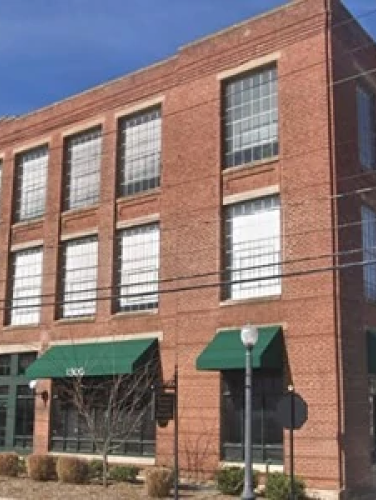
Textile Mill Supply Company
(ca. 1922)
The Textile Mill Supply Company Building is one of only two surviving uptown buildings associated with the textile mill supply business that supported Charlotte’s rise as a manufacturing center.
1300 S Mint St, Charlotte, NC 28203
Designed by the South Carolina architectural and engineering firm Lockwood, Green & Company and erected by Durham’s E. H. Clements Company, the revivalistic styled Textile Mill Supply Company Building is situated just south of Charlotte’s center city and northwest of the Wilmore neighborhood. For more than seventy years, the building housed enterprises that contributed to Charlotte’s emergence as a major textile manufacturing and distribution center in the late nineteenth and early twentieth centuries. The city’s thirteen textile mills built between 1889 and 1908 contributed significantly to the city’s sustained growth, but that success was fostered in large part by the creation of an urban infrastructure that included engineering firms, financial institutions, and department stores. Without the support of firms like the Textile Mill Supply Company and the Charlotte Manufacturing Company, both of which occupied the South Mint Street building for several years, cotton mills could not have proliferated in the Piedmont sections of the Carolinas in the early twentieth century.
Property Quick Links
Incorporated in 1898 by four former employees of the rival Charlotte Supply Company, the Textile Mill Supply Company sold and distributed supplies and components essential to the operation of industrial plants – especially textile mills – in the Carolinas, including pulleys, shafts, bearings, lubricants, couplers, spinning rings, ball bearings, electric motors, pumps, casters, and metal shelving. The Charlotte Manufacturing Company, makers of card clothing and loom reeds, leased space on the third floor of the same building until 1956, when that company relocated its operations to the Electric Supply and Equipment Company Building less than one block away on Penman Street. Card clothing is a sturdy specialized fabric with embedded wire teeth used to cover the rollers of a carding machine, a device used to disentangle, clean, and intermix textile fibers. The wire teeth manipulate the fibers, separating them and creating a continuous web or sliver suitable for spinning. A loom reed is a part of a weaving loom. Resembling a comb or a frame with vertical slits, the loom reed ensures even fabric structure by separating and spacing threads, guiding the shuttle, and pushing threads into place.
In 1958, the Textile Mill Supply Company merged with the local Industrial Hardware and Supply Company, creating the Industrial and Textile Supply Company. By 1967, that company had opened a distribution facility on West Franklin Avenue in Gastonia and another on Main Avenue Place in Hickory. The textile share of the Industrial and Textile Supply Company’s business gradually diminished as a greater variety of industrial customers was developed and as the number of nearby textile mills declined. In 1997, the Industrial and Textile Supply Company vacated its South Mint Street headquarters, moving to the Arrowood Industrial Park in southern Mecklenburg County. Its former headquarters were refurbished and converted into commercial office space. The only other Charlotte structure associated with the textile mill supply business, the Charlotte Supply Company Building (also designed by Lockwood, Green & Company), was torn down in the mid 1990s to make way for Bank of America Stadium, home of the NFL’s Carolina Panthers.

